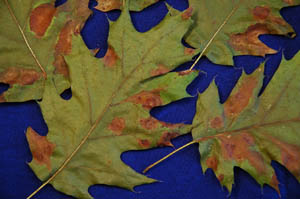Tubakia Leaf Spot of Trees�� | |
|---|---|
| September 11, 2006 | |
|
Lately we have seen many oaks with large leaf spots. This is different than anthracnose, so consultants and homeowners have questioned whether they should be concerned. This disease is not new but is still not as well known as anthracnose. It is called Tubakia leaf spot and is caused by the fungus Tubakia dryina. Oak is one of the primary hosts of this disease, but some other plant species that can be affected are maple, hickory, pecan, chestnut, redbud, ash, apple, black gum, rose, sassafras, and elm. Tubakia lesions may begin to appear in the middle of the summer; however, the symptoms are not fully visible until later in the season (now). Symptoms more often appear at the bottom or internally in the tree than elsewhere because conditions stay moist longer in those areas. Symptoms are described as angular, necrotic (red to black) areas with concentric rings. There may be a halo around the lesion. The pathogen forms fruiting structures that appear as tiny, dark discs within the lesion on both sides of the leaf. The symptoms described can be seen in the picture below.  The disease severity can also depend on the host susceptibility and environmental conditions. It has been reported that leaf spots are more likely to infect trees that have been stressed. For example, we see fungal leaf spots such as Tubakia leaf spot more often on pin oaks with iron chlorosis than on those without chlorosis. Oaks tend to have a greater susceptibility to this pathogen than some of the other hosts listed; and intense browning of the leaf and unsightly defoliation may occur. All things considered, Tubakia leaf spot of trees is not considered to be a serious disease. We do not recommend fungicide treatments to prevent infection. Do what you can to improve tree vitality, including watering in drought, pruning out dead wood, and keeping traffic off the root systems. Removing leaves in the fall may help reduce infection next spring. (Stephanie Porter��) | |
| Author: | Nancy Pataky |
